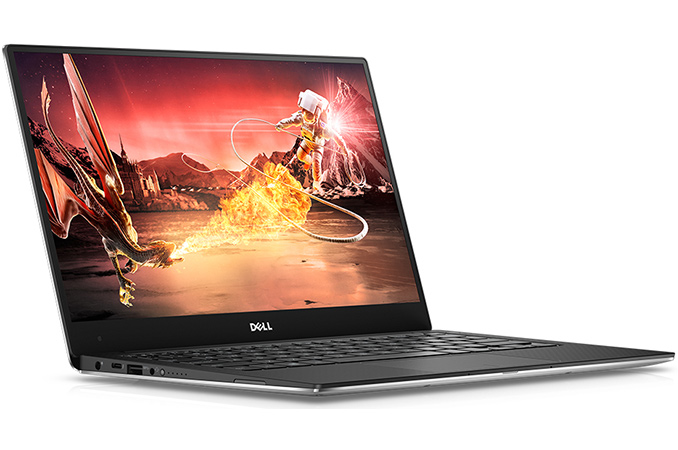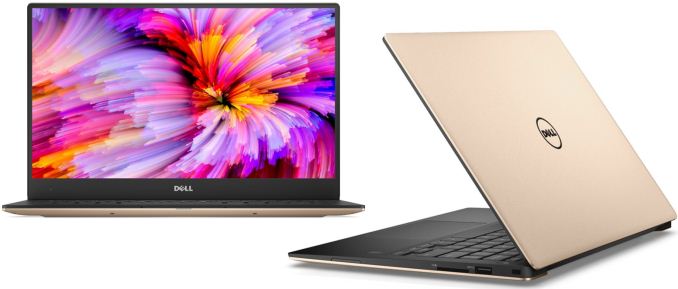Dell Updates XPS 13 with Intel’s Kaby Lake, Killer Wi-Fi, Now Also in Rose Gold
by Anton Shilov on September 15, 2016 5:45 PM EST
Dell on Thursday upgraded its XPS 13 ultra-thin laptop with Intel’s recently introduced Kaby Lake-U processors. The new notebooks keep the chassis and display panel options, but sport faster CPUs, speedier memory, a Killer 1535 802.11ac WiFi card, as well as a higher-capacity battery. Dell plans to offer new XPS 13 notebooks in rose gold, gold and silver colors starting from October 4, 2016.
Since Intel’s 7th generation Core i-series Kaby Lake-U processors are drop-in compatible with platforms supporting the Skylake-U chips, the new Dell XPS 13 uses exactly the same chassis as the Dell XPS 13 introduced a year ago and based on the previous-gen CPUs. That means, we are talking about systems made of machined aluminum and carbon fiber, which are 9 – 15 mm thick and weigh 1.2 – 1.29 kilograms. Display panels of the XPS 13 also remained the same: users can choose between a QHD+ (3200×1800) panel and an FHD (1920×1080) panel with or without touch support.
Meanwhile, the new 7th generation Intel Core CPUs run at higher frequencies s compared to their predecessors, feature considerably improved video encoding/decoding engine, refined graphics as well as Speed Shift v2 technology. As a result, the upgraded XPS 13 will deliver higher performance and better responsiveness at the same power than the predecessors. Otherwise, as with the past generation of systems, Dell is offering from 4GB to 16GB of LPDDR3-1866 memory.
Yet another improvement of the upgraded Dell XPS 13 is Rivet Networks' Killer 1535 802.11 2×2 Wi-Fi + BT 4.1 controller that promises to add some useful features with the help of refined software.
Finally, the 2016 XPS 13 also comes with a 60 Wh battery, up from 56 Wh battery on the previous-generation model. Dell claims that thanks to the new battery and power optimizations of the platform, the FHD version of the XPS 13 will work for up to 22 hours and the QHD+ machine will run for up to 13 hours on one charge.
| Dell XPS 13 | ||
| XPS 13 2015 |
XPS 13 2016 |
|
| CPU | Intel Core i3-6100U (2.3 GHz dual-core 15W) Intel Core i5-6200U (2.3-2.8 GHz dual-core 15W) Intel Core i5-6300U (2.4-3.0 GHz dual-core 15W) Intel Core i7-6500U (2.5-3.1 GHz dual-core 15W) Intel Core i7-6600U (2.6-3.4 GHz dual-core 15W) |
Intel Core i3-7100U (2.4 GHz dual-core 15W) Intel Core i5-7200U (2.5-3.1 GHz dual-core 15W) Intel Core i7-7500U (2.7-3.5 GHz dual-core 15W) |
| GPU | Intel HD 520 (24 EU) | Intel HD 620 (24 EU) |
| Memory | 4-16 GB dual-channel LPDDR3-1866 | 4-16 GB dual-channel LPDDR3-1866 |
| Display | 13.3" 1920x1080 sRGB 13.3" 3200x1800 sRGB |
|
| Storage | 128 GB SATA SSD, 256 GB, 512 GB, 1 TB PCIe SSD | |
| Battery | 56 Wh | 60 Wh |
| Wireless Connectivity | Intel 8260 802.11 2×2 Wi-Fi + BT 4.1 controller Dell 1820A 802.11 2×2 Wi-Fi + BT 4.1 controller |
Rivet Networks Killer 1535 802.11 2×2 Wi-Fi + BT 4.1 controller |
| Ports | Thunderbolt 3 x 1 (Type-C) USB 3.0 x 2 Headset SD Card Reader |
|
| Dimensions | 304 x 200 x 9-15 mm 11.98 x 7.88 x 0.33-0.6 inches |
|
| Weight | 1.2 - 1.29 kg 2.7 - 2.9 lbs |
|
| Price | $799+ | |
Other specs and features of the new Dell XPS 13 are the same as those on the 2015 model: PCIe SSD on higher-end models (the entry-level one still carries a 128 GB SATA drive), one Thunderbolt 3 port (hence, one USB Type-C receptacle), two USB 3.0 ports, an SD card reader and audio connectors.
Dell will begin to sell its XPS 13 in silver, gold and rose gold colors on October 4 starting at $799. Traditionally, the company will also offer XPS 13 Developer Edition based on Ubuntu 16.04 LTS starting at $949.
Source: Dell

















67 Comments
View All Comments
spikebike - Thursday, September 15, 2016 - link
Most of the upgrades for the XPS 13 I've seen were to get rid of the standard broadcom, not the intel wireless.Daniel Egger - Friday, September 16, 2016 - link
> Look at everyone here commenting on XPS 13 wifi chip without even owning this laptop, many owners were crying due to the pathetic intel wifi card used in the last xps 13 and many resorted to upgrading it themselves or returning the laptop.The regular (non-developer) XPSes came with a Broadcom solution, since Broadcom doesn't work so hot on Linux. For some strange reason the only vendor who is really capable of implementing a "killer" network based on Broadcom is Apple. For anyone else the solution to fix a crappy out-of-the-box network is to go Intel...
tuxRoller - Monday, September 19, 2016 - link
And Linux running on Apple hardware, I might add.How surprised was I that once my gf's MacBook pro had Linux, and the blob driver, installed, and using akmod to handle kernel updates, things Just Worked (as far as network goes---to get access to the Intel gpu was a very unfun thing). Amazingly, it even comes back up after resume.
ik9000 - Thursday, September 22, 2016 - link
The intel 8260 had a 5GHz error on the original drivers (2.4Ghz worked fine). It was sorted out with a driver update and has since been rock-solid. The Dell broadcom wireless options have proved less popular. I've only had te intel version, and no complaints with it. V glad I got it over the dell broadcom one, which I've not heard favourable things about. I also have a decent 5GHz router which no doubt helps.tynopik - Thursday, September 15, 2016 - link
"frequencies s compared"Cellar Door - Thursday, September 15, 2016 - link
Why no DDR4?NextGen_Gamer - Thursday, September 15, 2016 - link
I could be wrong, but I think both Skylake-U and Kaby Lake-U only support LPDDR3? Same goes for the Skylake/Kaby Lake Core m-series. Both of which makes no sense to me: the so-called "low-power" series have to use LPDDR3, at 1.35 volts - even though normal DDR4 uses 1.20 volts... :/vladx - Thursday, September 15, 2016 - link
That's because lower voltage doesn't necessarily mean less powerCellar Door - Friday, September 16, 2016 - link
I have a work Dell 7470 with an i7-6600U and 16GB of DDR4 2133.. and this is already 6 months oldjospoortvliet - Sunday, December 25, 2016 - link
... but not LPDDR4 ;-)